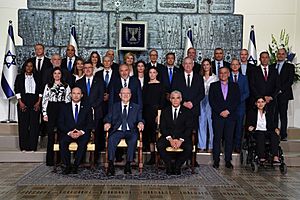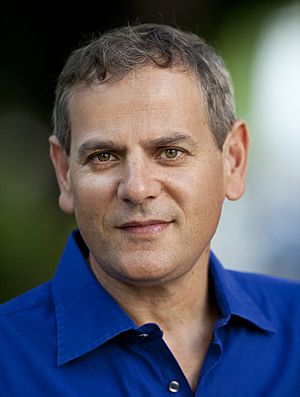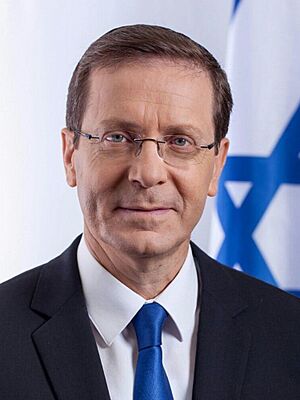Thirty-sixth government of Israel facts for kids
Quick facts for kids Bennett–Lapid government |
|
|---|---|
36th Cabinet of Israel |
|

Ministers of the Bennett–Lapid government
with President Reuven Rivlin |
|
| Date formed | 13 June 2021 |
| Date dissolved | 29 December 2022 |
| People and organisations | |
| President | Reuven Rivlin Isaac Herzog |
| Prime minister | Naftali Bennett (2021–2022) Yair Lapid (July 2022–Dec 2022) |
| Alt. prime minister | Yair Lapid (2021–2022) Naftali Bennett (July–Nov 2022) |
| No. of ministers | 27 |
| Member parties |
|
| Status in legislature |
|
| Opposition parties |
|
| Opposition leader | Benjamin Netanyahu |
| History | |
| Election(s) | 2021 Knesset election |
| Legislature term(s) | 24th Knesset |
| Incoming formation | 2019–2022 political crisis |
| Predecessor | 35th government |
| Successor | 37th government |
The thirty-sixth government of Israel, also known as the Bennett–Lapid government, was a group of leaders who ran the country of Israel. It was formed on June 13, 2021, after the 2021 Israeli legislative election. This government was special because it brought together many different political parties.
The government had two prime ministers. First, Naftali Bennett from the Yamina party was Prime Minister. Then, as part of a special deal, Yair Lapid from the Yesh Atid party took over on July 1, 2022. Lapid served as a temporary Prime Minister until new elections were held. This government was also the first to include an independent Arab Israeli party as an official member. It was replaced by the 37th government on December 29, 2022.
Contents
How Israel's 36th Government Was Formed
After the 2021 election, no single group of parties won enough seats to form a government easily. This meant that different parties had to work together to create a ruling group. The President of Israel, Reuven Rivlin, met with all the elected parties to hear their ideas for who should be Prime Minister.
The First Try to Form a Government
On April 6, 2021, President Rivlin first asked Benjamin Netanyahu to try and form a government. Netanyahu was the leader of the Likud party. He had until May 4 to get enough parties to agree to work together.
During this time, Netanyahu offered deals to other party leaders. He suggested a "rotation agreement." This means two leaders would share the Prime Minister job, each serving for a part of the time. However, Netanyahu was not able to form a government by the deadline.
The Second Try to Form a Government
After Netanyahu's attempt, President Rivlin asked Yair Lapid of the Yesh Atid party to try and form a government. This happened on May 5, 2021. Lapid was supported by 56 members of the Knesset (Israel's parliament).
Lapid worked to create a "change bloc" government. This was a group of parties that wanted a new government without Netanyahu. This group included parties from across the political map, from right-wing to left-wing. They even considered including the United Arab List, an Arab Israeli party.
The parties discussed many things. They talked about who would get which government jobs. They also discussed important laws, like rules about marriage and how to deal with crime. One big idea was that Naftali Bennett and Yair Lapid would each serve as Prime Minister for two years.
Challenges and Delays
The talks faced many challenges. On May 10, 2021, fighting broke out in Jerusalem and rockets were fired. This caused the talks to stop for a while. The United Arab List said they would not continue talks until the situation was calm.
Then, Naftali Bennett of the Yamina party said he no longer wanted a government that relied on the United Arab List. He felt such a government would not be strong enough to handle the country's security problems. He then tried to form a different kind of "unity government" with Likud.
However, Bennett later changed his mind again. By May 23, he was open to working with Lapid once more. Many parties, including Meretz and the Labor Party, agreed to join a "change government." On May 30, Bennett announced he was in favor of a unity government. He would be Prime Minister first, then Lapid would take over.
The Final Agreement
On June 1, 2021, the United Arab List announced they would fully join the "change government." This was a big step. However, some members of other parties were still unsure about supporting the new government.
Despite these challenges, on the night of June 2, 2021, just before his deadline, Yair Lapid told President Reuven Rivlin that he had formed a new government. This meant that a new government could be voted on by the Knesset.
The final agreements included several key policies. They planned to set term limits for the Prime Minister. They also aimed to improve services for older people and war veterans. Other plans included changes to religious services and environmental protection.
The Vote to Approve the Government
On June 13, 2021, the Knesset held a vote to approve the new government. This is called an "investiture vote." The new government needed at least 61 votes to pass.
The vote was very close: 60 members voted yes, and 59 voted no. One member from the United Arab List chose not to vote. Because of this close vote, the Bennett-Lapid government was approved and officially took office. Naftali Bennett became Israel's 13th Prime Minister.
Who Was in the Government?
The 36th government included ministers from many different parties. Here are some of the main ministers:
Ministers
| Portfolio | Minister | Party | |
|---|---|---|---|
| Prime Minister Minister of Foreign Affairs Minister of Strategic Affairs |
Yair Lapid | Yesh Atid | |
| Alternate Prime Minister of Israel Minister of Community Affairs |
Naftali Bennett | Yamina | |
| Deputy Prime Minister Minister of Defense |
Benny Gantz | Blue and White | |
| Minister of Justice | Gideon Sa'ar | New Hope | |
| Minister of Agriculture and Rural Development Minister for the Development of the Periphery, the Negev, and the Galilee |
Oded Forer | Yisrael Beiteinu | |
| Minister of Aliyah and Integration | Pnina Tamano-Shata | Blue and White | |
| Minister of Communications | Yoaz Hendel | New Hope | |
| Minister of Housing and Construction Minister of Jerusalem Affairs and Heritage |
Ze'ev Elkin | New Hope | |
| Minister of Culture and Sport | Hili Tropper | Blue and White | |
| Minister of Diaspora Affairs | Nachman Shai | Labor Party | |
| Minister of the Economy | Orna Barbivai | Yesh Atid | |
| Minister of Education | Yifat Shasha-Biton | New Hope | |
| Minister of Environmental Protection | Tamar Zandberg | Meretz | |
| Minister of Finance | Avigdor Lieberman | Yisrael Beiteinu | |
| Minister in the Finance Ministry | Hamad Amar | Yisrael Beiteinu | |
| Minister of Health | Nitzan Horowitz | Meretz | |
| Minister of Intelligence | Elazar Stern | Yesh Atid | |
| Minister of the Interior | Ayelet Shaked | Yamina | |
| Minister of Labor, Social Affairs, and Social Services | Meir Cohen | Yesh Atid | |
| Minister of National Infrastructure, Energy, and Water | Karine Elharrar | Yesh Atid | |
| Minister of Public Security Minister for Community Empowerment and Advancement |
Omer Bar-Lev | Labor Party | |
| Minister of Regional Cooperation | Issawi Frej | Meretz | |
| Minister of Religious Affairs | Matan Kahana | Yamina | |
| Minister of Science and Technology | Orit Farkash-Hacohen | Blue and White | |
| Minister for Social Equality | Meirav Cohen | Yesh Atid | |
| Minister of Tourism | Yoel Razvozov | Yesh Atid | |
| Minister of Transportation | Merav Michaeli | Labor Party | |
| Minister without portfolio | Mansour Abbas | United Arab List | |
Deputy Ministers
| Portfolio | Minister | Party | |
|---|---|---|---|
| Deputy Minister of Economic Reforms in the Prime Minister's office | Abir Kara | Yamina | |
| Deputy Minister of Defense | Alon Schuster | Blue and White | |
| Deputy Minister of Foreign Affairs | Idan Roll | Yesh Atid | |
| Deputy Minister of Education | Meir Yitzhak Halevi | New Hope | |
| Deputy Minister of Internal Security | Yoav Segalovich | Yesh Atid | |
| Deputy Minister of the Economy | Yair Golan | Meretz | |
How the Government Ended
On June 20, 2022, after facing several challenges in the Knesset, Prime Ministers Bennett and Lapid announced that they would dissolve the government. This meant new elections would be held. The government lost support when some members withdrew their backing.
The Knesset officially voted to dissolve itself on June 29, 2022. New elections were set for November 1, 2022. Naftali Bennett decided to leave politics and was replaced as leader of his party by Ayelet Shaked.
On June 30, Yair Lapid became the temporary Prime Minister. He served in this role until a new government was formed after the elections.
See also
- 2018–2022 Israeli political crisis
- List of members of the twenty-fourth Knesset









